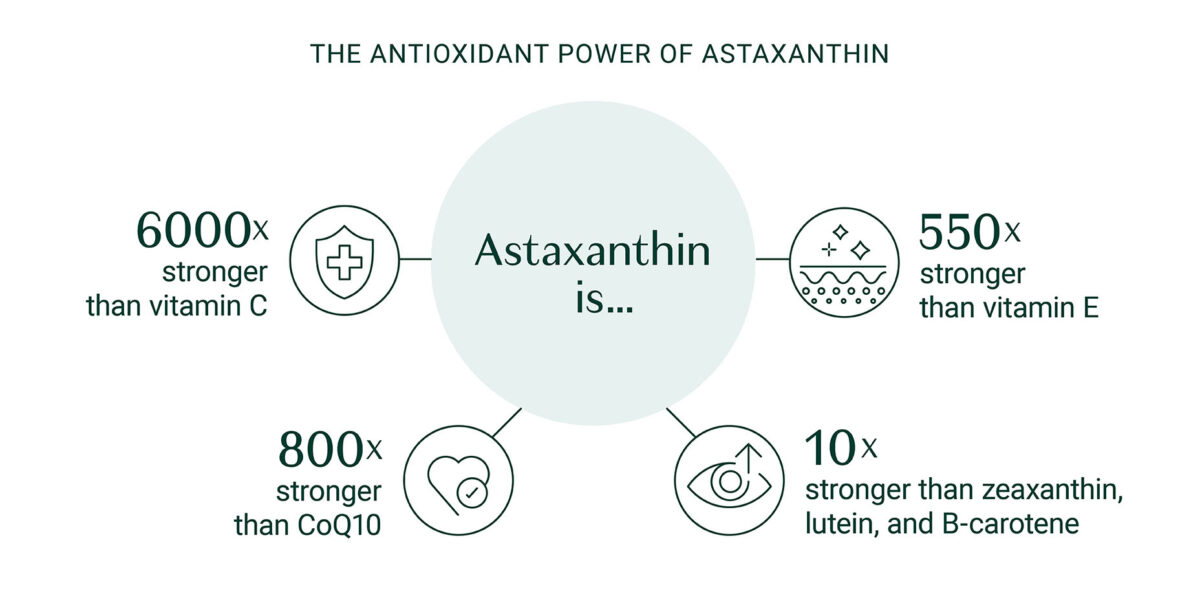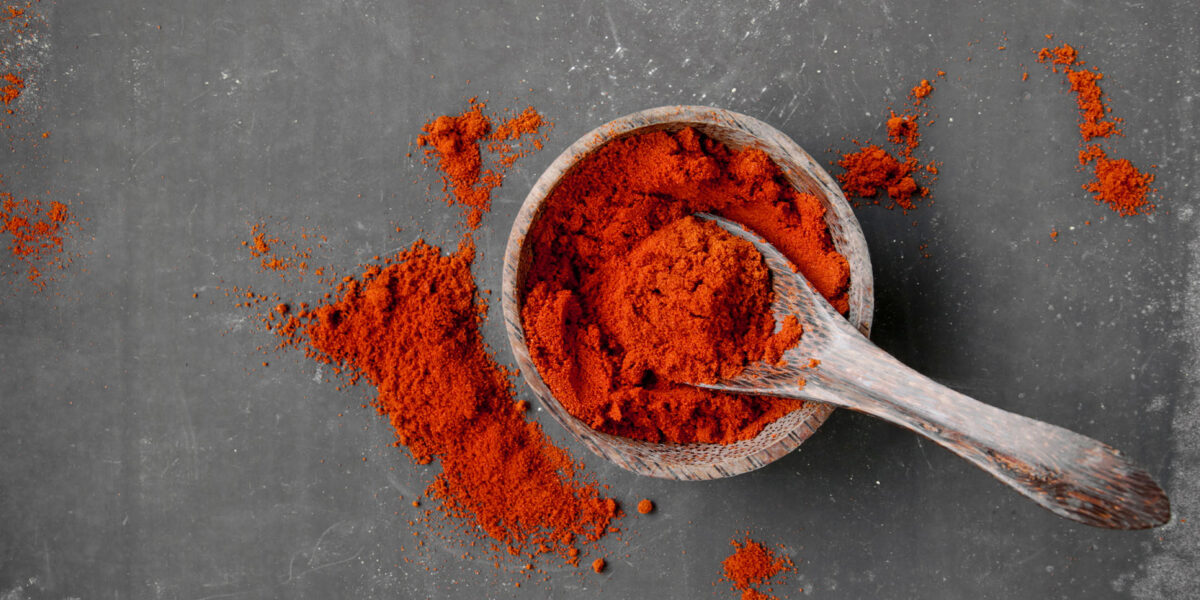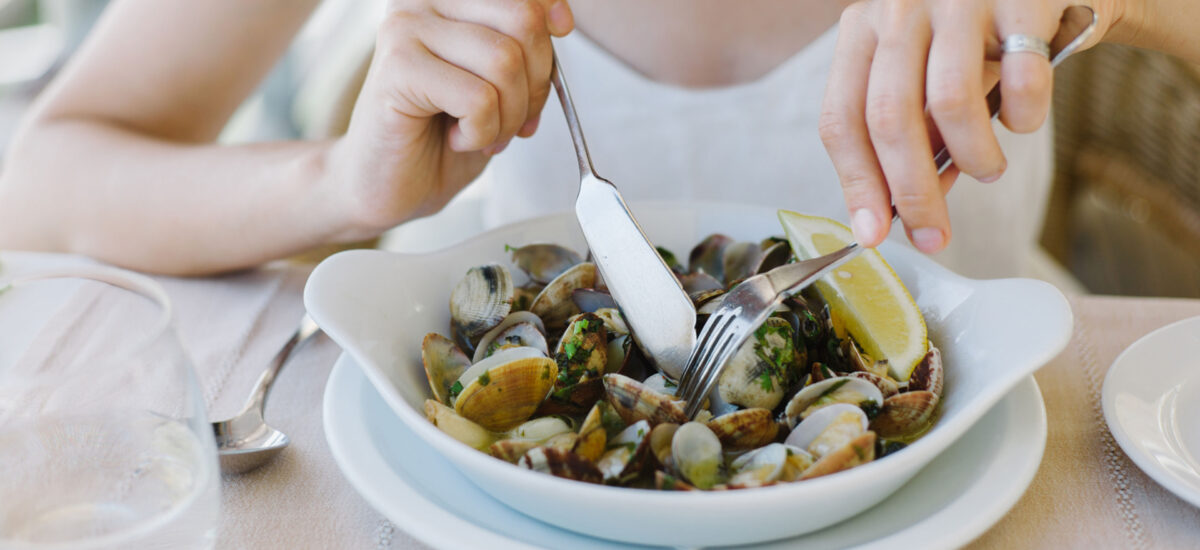Astaxanthin is a powerful antioxidant and anti-inflammatory compound that falls under the carotenoid category of phytochemicals. Most carotenoids, including beta-carotene, lutein, zeaxanthin, and lycopene, exude beautiful orange, red, and yellow colors, which is why we often find these nutrients in produce like tomatoes, carrots, and pumpkins.
Astaxanthin, on the other hand, is a bit special as this phytonutrient isn’t found in produce but comes primarily from microalgae. Therefore, if you want to get more astaxanthin in your diet, you’ll have to look to marine life that consumes algae, such as salmon and shrimp (note their orange-pink color).
But before we get ahead of ourselves, let’s look at why you want to get more astaxanthin in your diet in the first place.
In this article, we’ll discuss:
- The many health benefits of astaxanthin
- How astaxanthin stacks up against other antioxidants
- The optimal dosage for astaxanthin
- Tips for buying a high-quality astaxanthin supplement
- And more
The Many Health Benefits of Astaxanthin
Astaxanthin is a relatively new compound in the health scene. While it was first discovered in 1938, researchers have only just begun to uncover all of the potential health benefits associated with this nutrient.
That said, just five years ago, there were already around 2,000 research articles published on astaxanthin, and today there are well over 3,000 – pretty good for the new kid [1].
As already mentioned, astaxanthin is a potent antioxidant and anti-inflammatory compound, but research to date has shown that the benefits of astaxanthin are much more specific than general inflammation and oxidative stress.
Let’s dig in.

Bone Health
Anything that combats inflammation and oxidative stress is going to have a positive effect on your bones. However, research shows that astaxanthin may specifically impact the activity of osteoclast cells (the ones that break down bone) and, therefore, may assist in preserving bone density [2].
Heart Health
It’s well understood that inflammation and oxidative stress play significant roles in the progression of heart disease. Studies show that astaxanthin may help to protect heart health by reducing inflammation and specifically inhibiting the oxidation of LDL cholesterol – a key step in the progression of atherosclerotic plaque formation [3][4].
Cognitive Health
Animal research suggests that astaxanthin’s ability to suppress the inflammatory response may be responsible for improved cognitive function in cerebrovascular diseases such as vascular dementia [5].
In human trials, studies show that taking astaxanthin results in improved memory function in adults experiencing memory decline [6][7].
Immunity
Inflammation and oxidative stress are intimately tied to your immune response, which makes it no surprise that astaxanthin has been shown to support immune function. In one study, a group of participants taking astaxanthin for eight weeks showed increased activity in several lines of immune cells and reduced levels of c-reactive protein, a marker for inflammation [8].
Vision
Studies show that astaxanthin may protect eye health via several mechanisms, including its anti-inflammatory, antioxidant, and antiapoptotic (anti-cell death) activity. By disrupting the damaging activity of free radicals in the eye, astaxanthin may benefit age-related macular degeneration, cataract, glaucoma, and corneal damage [9].
Skin Health
Want healthier, younger-looking skin? Protect yourself from ultraviolet (UV) rays. UV rays are responsible for a great deal of skin aging as they slowly deteriorate the skin’s barrier, resulting in wrinkles, leathery skin texture, and reduced elasticity. Due to the antioxidant activity of astaxanthin, studies show that this compound may protect the skin against oxidative damage and therefore reduce signs of aging [10][11].
Male Fertility
Some studies show promise for astaxanthin, as an antioxidant, in improving sperm function in male infertility. That said, more studies need to be conducted before we draw any firm conclusions [12][13].
Muscular Endurance and Performance
Strenuous exercise training can result in increased production of reactive oxygen species (ROS), which may consequently result in cellular damage. Research shows that the antioxidant potential of astaxanthin may support your body in combating, or even preventing, the production of exercise-induced ROS and, therefore, may protect your cells and tissue from exercise-induced damage [14].
This improvement in antioxidant activity may enhance exercise performance. In one trial, 21 competitive cyclists improved their cycling time performance after 28 days of supplementing with astaxanthin [15].

How Does Astaxanthin Stack Up Against Other Antioxidants?
There are plenty of antioxidants out there, so what makes astaxanthin so special? In study after study, astaxanthin has proved to be one of the most powerful antioxidants found in nature. Let’s take a look at how astaxanthin stacks up against some other common antioxidant compounds.
Vitamin C vs. Astaxanthin
Vitamin C is well-known for its immune-enhancing properties, as well as being a potent antioxidant. There’s a good reason we’re told to stock up on this vitamin during the flu season.
When compared to astaxanthin, however, studies show that astaxanthin is 6000 times more powerful than vitamin C [16].
Vitamin E vs. Astaxanthin
Vitamin E is a fat-soluble vitamin that’s most well-known for its role in protecting skin health – much like astaxanthin. But when you compare the two in terms of free-radical scavenging potency, astaxanthin is the winner with 550 times more antioxidant activity than vitamin E [16].
CoQ10 vs. Astaxanthin
CoQ10 is a coenzyme and antioxidant naturally produced by your body that’s known to be heart-protective, neuroprotective, and may enhance physical stamina due to its role in energy production.
That said, when comparing the two, research shows astaxanthin is 800 times more powerful than CoQ10 [16].
Zeaxanthin vs. Astaxanthin
Zeaxanthin is a type of carotenoid that’s found in abundance in your eyes. Research shows that zeaxanthin has potent antioxidant properties and can be especially helpful in conditions that impact the eyes such as macular degeneration and cataract.
As mentioned, astaxanthin has also been studied for its potential eye-health benefits, and when these two carotenoids are compared astaxanthin comes out on top as ten times more powerful than zeaxanthin [17].
Lutein vs. Astaxanthin
Lutein is another carotenoid with a claim to fame focused around eye health. Just like zeaxanthin, however, lutein doesn’t compare to the antioxidant powerhouse of astaxanthin. In fact, astaxanthin is also 10 times more potent than lutein [17].
β-carotene vs. Astaxanthin
In addition to eye health, β-carotene is a carotenoid known to enhance immunity and protect skin from UV damage.
As one of the most well-known carotenoids, β-carotene still doesn’t hold up next to astaxanthin – which is 10 times more powerful than β-carotene [18].
Phytonutrients are known to be powerhouses when it comes to antioxidant capacity. Still, even next to phytochemicals in its own class (β-carotene, zeaxanthin, and lutein), astaxanthin is ten times more powerful – that’s impressive.
Astaxanthin Dosage
While a handful of foods contain astaxanthin, you would have to be pretty diligent about your diet if you wanted to increase your astaxanthin intake through diet alone. For example, the most potent dietary source of astaxanthin is sockeye salmon, but you would have to consume eight ounces of salmon every day to get a meaningful amount [19].
While salmon and other fish have plenty of health benefits, if you really want to increase your astaxanthin intake, it’s best to go with a high-quality supplement. What exactly is a “high-quality supplement”? We’ll go into detail on that question in the next section. For now, let’s look at the optimal dose of astaxanthin.
Currently, there is no official daily recommended intake for astaxanthin – as is true for most phytonutrients. That said, most clinical trials have studied the effects of astaxanthin at a dose range between 1 and 40 mg. That’s a pretty wide range, but at the beginning of 2020, the European Food Safety Authority (EFSA) confirmed that astaxanthin supplementation at levels of up to 8 mg a day could be used without any risk to health [20].
This is likely a conservative number, but it is a fair guideline.

Tips for Choosing The Best Astaxanthin Supplement
So now that you know how powerful astaxanthin is, how do you choose a high-quality supplement? When it comes to this nutrient in particular, there are three things to pay attention to:
#1. Opt For All-Natural
You’ll find two main types of astaxanthin: esterified astaxanthin and non-esterified astaxanthin. The difference is that esterified astaxanthin has a fatty molecule attached, while non-esterified astaxanthin is “free.” In basic terms, esterified astaxanthin is natural, and non-esterified astaxanthin is largely a synthetic, chemical version.
Generally speaking, whenever you can get supplements in their natural form, it’s always best. When compounds are produced in a lab, you never know how well they will interact with a biological system (like your body). Natural compounds have been produced by mother nature and therefore tend to be absorbed and assimilated optimally. Furthermore, synthetic astaxanthin was developed to feed farmed salmon to give them a desirable, consumer-friendly color. It has not been extensively studied regarding safety for human consumption.
#2. Combine With Fish Oil
Astaxanthin is a powerful antioxidant, but this nutrient is fat-soluble, which means that for optimal bioavailability, it must be taken with a source of fat.
While you could combine astaxanthin with any fat, studies show that omega-3-rich oils are the ideal carriers for astaxanthin. If you think about it from the perspective of the natural world, this makes a lot of sense since astaxanthin and omega-3 oils both come from the same primary source; microalgae [21].
Furthermore, fish oil and astaxanthin have similar anti-inflammatory and antioxidant activities, making them a perfect pairing.
That’s precisely why AlgaeCal’s Triple Power Omega 3 Fish Oil comes packed with omega-3 fats, astaxanthin, and curcumin. When it comes to fighting inflammation and oxidative stress, the more, the merrier.
Astaxanthin Side Effects
Astaxanthin taken at levels provided by most supplements has been shown in clinical trials to be safe, particularly if you stay below that 8 mg per day range [22].
That said, there are some potential side effects that can come with astaxanthin when taken in extremely high doses (50mg or more). These include [23][24]:
- Orange pigmentation of the skin
- Lowered blood sugar levels
- Lowered blood pressure
- Inhibition of 5-alpha-reductase, thereby inhibiting the conversion of testosterone to dihydrotestosterone (DHT)
Due to its potential immune-enhancing activity, astaxanthin should be used cautiously in those autoimmune disorders or people taking immunosuppressants.
Please note: As we’ve outlined, astaxanthin is considered safe for humans to consume. But there’s still not enough research on the safety of astaxanthin for pregnant women. So we advise pregnant women to check with their healthcare provider before adding astaxanthin to their diet in any meaningful amount.
Takeaway
Astaxanthin may be newish on the scene, but the research so far is nothing less than astounding. With 6000 times more antioxidant activity than vitamin C and 10 times more activity than its counterpart phytonutrients – this is one antioxidant that deserves a special place in your diet.
If you’re looking for ways to boost your antioxidant defenses with astaxanthin, look no further than Triple Power Omega 3 Fish Oil. In addition to over 1400 mg of omega 3s, one tablespoon of Triple Power Omega 3 Fish Oil provides 3 mg of astaxanthin – about as much as you would get in one serving of sockeye salmon.
And the best part is that instead of that fishy taste that normally comes with these oils, Triple Power Omega 3 Fish Oil has a delicious mango flavor. Yes, if you have kids, they’ll be begging you for more fish oil. When was the last time that happened?
To learn more about all things bone health and healthy aging, sign up for the AlgaeCal Newsletter.
What is astaxanthin derived from?
Astaxanthin is naturally derived from microalgae, yeast, and marine life that consume algae, such as salmon, krill, and shrimp.
What is astaxanthin good for?
Astaxanthin is a powerful antioxidant and anti-inflammatory compound that may benefit heart health, bone health, cognitive health, vision, immunity, endurance, and male fertility.
How much astaxanthin should you take per day?
The European Food Safety Authority (EFSA) confirmed that astaxanthin supplementation at levels of up to 8 mg per day can be used without any risk to health.
Is astaxanthin hard on kidneys?
Studies show that astaxanthin may have a protective effect on kidney disease due to its role in reducing oxidative stress and inflammation.
How long does it take to see astaxanthin benefits?
The time it takes to see benefits from astaxanthin will depend on your current health status and the dose and quality of your supplement. That said, many people start experiencing benefits within four to eight weeks.
Is astaxanthin better than CoQ10?
Astaxanthin is 800 times more powerful as an antioxidant when compared to CoQ10.
References
- https://pubmed.ncbi.nlm.nih.gov/?term=astaxanthin
- Hwang, Y. H., Kim, K. J., Kim, S. J., Mun, S. K., Hong, S. G., Son, Y. J., & Yee, S. T. (2018). Suppression effect of astaxanthin on osteoclast formation in vitro and bone loss in vivo. International Journal of Molecular Sciences, 19(3), 912.
- Fassett, R. G., & Coombes, J. S. (2009). Astaxanthin, oxidative stress, inflammation and cardiovascular disease. Future cardiology, 5(4), 333-342.
- Iwamoto, T., Hosoda, K., Hirano, R., Kurata, H., Matsumoto, A., Miki, W., … & Kondo, K. (2000). Inhibition of low-density lipoprotein oxidation by astaxanthin. Journal of atherosclerosis and thrombosis, 7(4), 216-222.
- Zhu, N., Liang, X., Zhang, M., Yin, X., Yang, H., Zhi, Y., … & Li, H. (2020). Astaxanthin protects cognitive function of vascular dementia. Behavioral and Brain Functions, 16, 1-10.
- Sekikawa, T., Kizawa, Y., Li, Y., & Takara, T. (2020). Cognitive function improvement with astaxanthin and tocotrienol intake: A randomized, double-blind, placebo-controlled study. Journal of Clinical Biochemistry and Nutrition, 67(3), 307-316.
- Katagiri, M., Satoh, A., Tsuji, S., & Shirasawa, T. (2012). Effects of astaxanthin-rich Haematococcus pluvialis extract on cognitive function: a randomised, double-blind, placebo-controlled study. Journal of clinical biochemistry and nutrition, 51(2), 102-107.
- Park, J. S., Chyun, J. H., Kim, Y. K., Line, L. L., & Chew, B. P. (2010). Astaxanthin decreased oxidative stress and inflammation and enhanced immune response in humans. Nutrition & metabolism, 7, 1-10.
- Giannaccare, G., Pellegrini, M., Senni, C., Bernabei, F., Scorcia, V., & Cicero, A. F. G. (2020). Clinical applications of astaxanthin in the treatment of ocular diseases: Emerging insights. Marine drugs, 18(5), 239.
- Davinelli, S., Nielsen, M. E., & Scapagnini, G. (2018). Astaxanthin in skin health, repair, and disease: A comprehensive review. Nutrients, 10(4), 522.
- Ito, N., Seki, S., & Ueda, F. (2018). The protective role of astaxanthin for UV-induced skin deterioration in healthy people—A randomized, double-blind, placebo-controlled trial. Nutrients, 10(7), 817.
- Donà, G., Kožuh, I., Brunati, A. M., Andrisani, A., Ambrosini, G., Bonanni, G., … & Bordin, L. (2013). Effect of astaxanthin on human sperm capacitation. Marine drugs, 11(6), 1909-1919.
- Comhaire, F. H., Garem, Y. E., Mahmoud, A. H. M. E. D., Eertmans, F., & Schoonjans, F. R. A. N. K. (2005). Combined conventional/antioxidant “Astaxanthin” treatment for male infertility: a double blind, randomized trial. Asian Journal of Andrology, 7(3), 257-262.
- Brown, D. R., Gough, L. A., Deb, S. K., Sparks, S. A., & McNaughton, L. R. (2018). Astaxanthin in exercise metabolism, performance and recovery: a review. Frontiers in nutrition, 4, 76.
- Earnest, C. P., Lupo, M., White, K. M., & Church, T. S. (2011). Effect of astaxanthin on cycling time trial performance. International journal of sports medicine, 32(11), 882-888.
- Zhang, Z. W., Xu, X. C., Liu, T., & Yuan, S. (2016). Mitochondrion-permeable antioxidants to treat ROS-burst-mediated acute diseases. Oxidative Medicine and Cellular Longevity, 2016.
- Giannaccare, G., Pellegrini, M., Senni, C., Bernabei, F., Scorcia, V., & Cicero, A. F. G. (2020). Clinical applications of astaxanthin in the treatment of ocular diseases: Emerging insights. Marine drugs, 18(5), 239.
- https://www.sciencedirect.com/topics/neuroscience/astaxanthin
- Ambati, R. R., Siew Moi, P., Ravi, S., & Aswathanarayana, R. G. (2014). Astaxanthin: Sources, extraction, stability, biological activities and its commercial applications—A review. Marine drugs, 12(1), 128-152.
- EFSA Panel on Nutrition, Novel Foods and Food Allergens (NDA), et al. “Safety of astaxanthin for its use as a novel food in food supplements.” EFSA Journal 18.2 (2020): e05993.
- Ambati, R. R., Siew Moi, P., Ravi, S., & Aswathanarayana, R. G. (2014). Astaxanthin: Sources, extraction, stability, biological activities and its commercial applications—A review. Marine drugs, 12(1), 128-152.
- Fassett, R. G., & Coombes, J. S. (2011). Astaxanthin: a potential therapeutic agent in cardiovascular disease. Marine drugs, 9(3), 447-465.
- Al Nasser, Y., Jamal, Z., & Albugeaey, M. (2021). Carotenemia. In StatPearls [Internet]. StatPearls Publishing.
- https://www.naturalmedicinejournal.com/journal/astaxanthin-review-literature






Dagmar
June 18, 2017 , 8:29 amSuper informative article! Thank you AlgaeCal team for your great work!!!